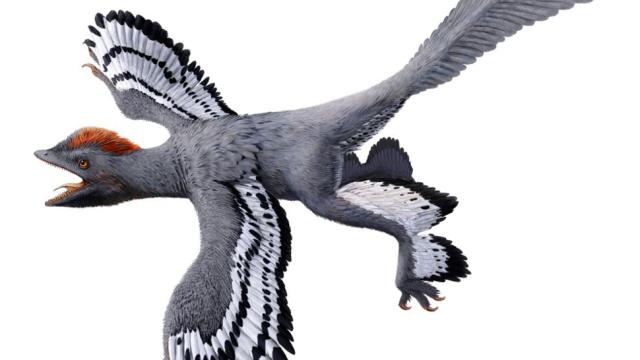Using high-powered lasers, palaeontologists have detected rare traces of soft tissue in the fossilised remains of Anchiornis — a four-winged dinosaur that lived during the late Jurassic period. The findings are offering new insights into the origin of birds and the development of flight.
An updated reconstruction of Anchiornis using the new body outline using laser-stimulated fluorescence data. (Image: Julius T. Csotonyi)
A research team led by Michael Pitman from the Department of Earth Sciences at the University of Hong Kong used an exciting new technique called laser-stimulated fluorescence (LSF) to reveal the delicate contours of soft tissue around the fossilised bones of a dinosaur called Anchiornis. The new study, published today in Nature, is the first to show a highly accurate body outline of a feathered dinosaur, offering an unprecedented look at this 160 million-year-old creature. Incredibly, Anchiornis exhibited many traits of modern birds, pushing back the emergence of important bird-like features to the Late Jurassic.
Traces of soft tissue are rarely found in fossils, making it difficult for scientists to discern the exact shape of an extinct animal. Typically, scientists look at the skeletal structure embedded within a fossil, and then compare it to animals alive today, such as lizards and ostriches. This often leads to imperfect results. Consequently, many of the functional aspects of dinosaur physiology are still unknown, including features responsible for gliding and flight.
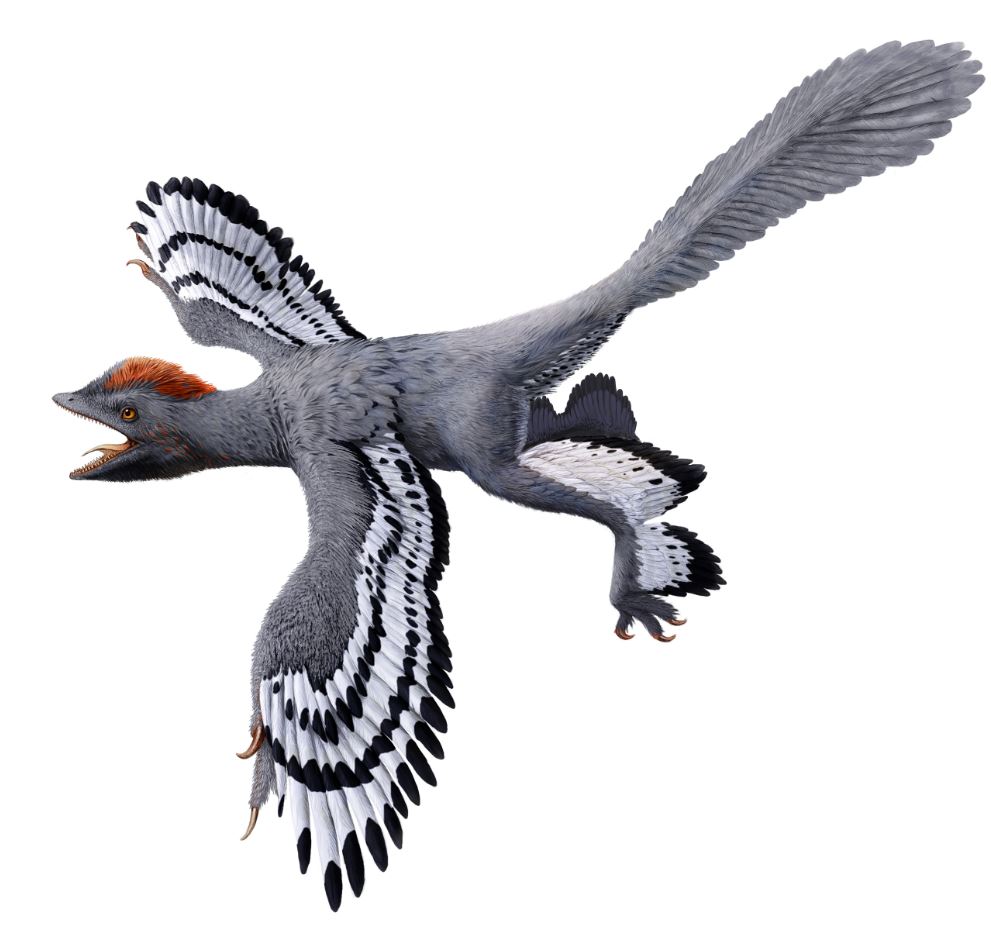
Image: Julius T. Csotonyi
In an effort to extend the information embedded within a fossil, Pitman and his colleagues used high-powered ultraviolet lasers to visualise features that would be undetectable under regular light.
“Laser-stimulated fluorescence (LSF) is a revolutionary new technique using high power lasers that makes unseen soft tissues preserved alongside the bones, literally ‘glow in the dark’ by fluorescence,” Pitman told Gizmodo. “The technique — developed by collaborator Tom Kaye of the Foundation for Scientific Advancement — scans the fossils with a violet laser in a dark room. The laser ‘excites’ the few skin atoms left in the [fossil] making them glow, to reveal what the shape of the dinosaur actually looked like.”
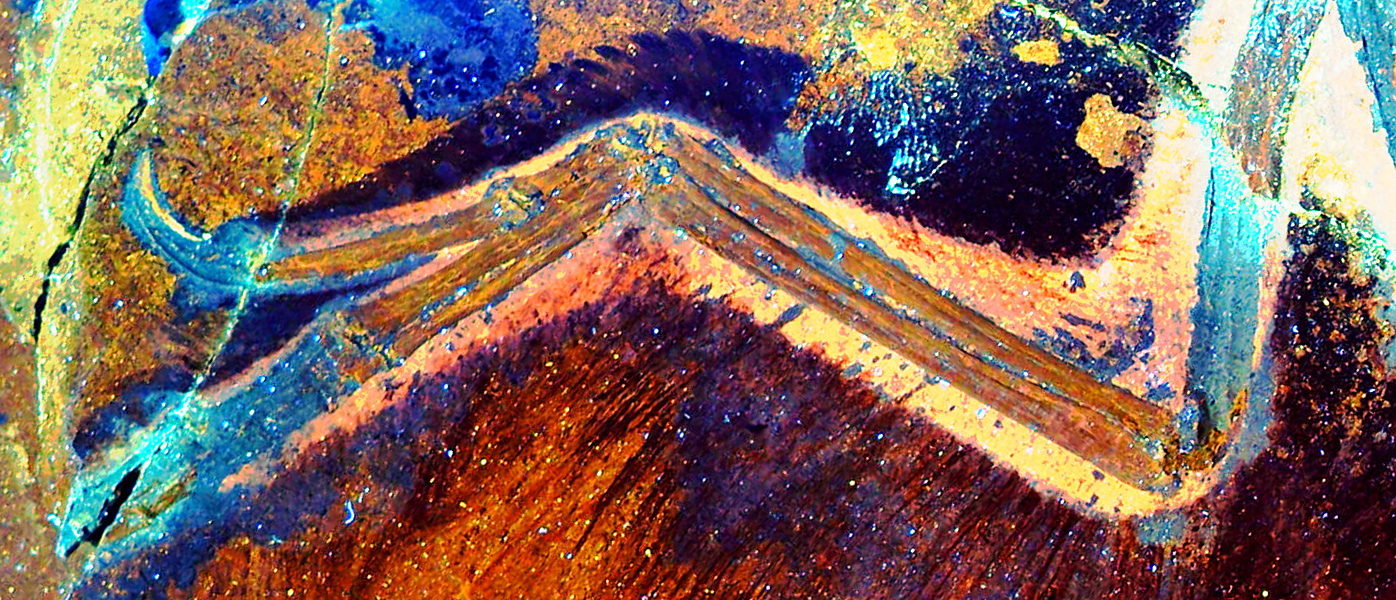
The folds of skin in front of the elbow and behind the wrist — called propatagium — were covered in feathers, just like in modern living birds. (Image: Wang XL, Pittman M et al. 2017.)
The technique has been used previously to reconstruct the colour patterns of a Cretaceous-era dinosaur called Psittacosaurus, and to discern the shape of ancient plants. The new study is the first to try it on a four-winged dinosaur.
The researchers chose to apply LSF on Anchiornis as it’s one of only a few early examples of bird-like dinosaurs in the fossil record, a list that includes Microraptor and Archaeopteryx. The study of these early feathered, winged dinos — with their unique body shapes, feathering and apparent aerodynamics — have contributed greatly to our understanding of the origin of birds and early flight evolution. Anchiornis is also a good species for study owing to the rich palaeontological record. There are at least 229 known specimens, significantly improving the researchers’ chance of discovering traces of soft tissue preservation in the samples.
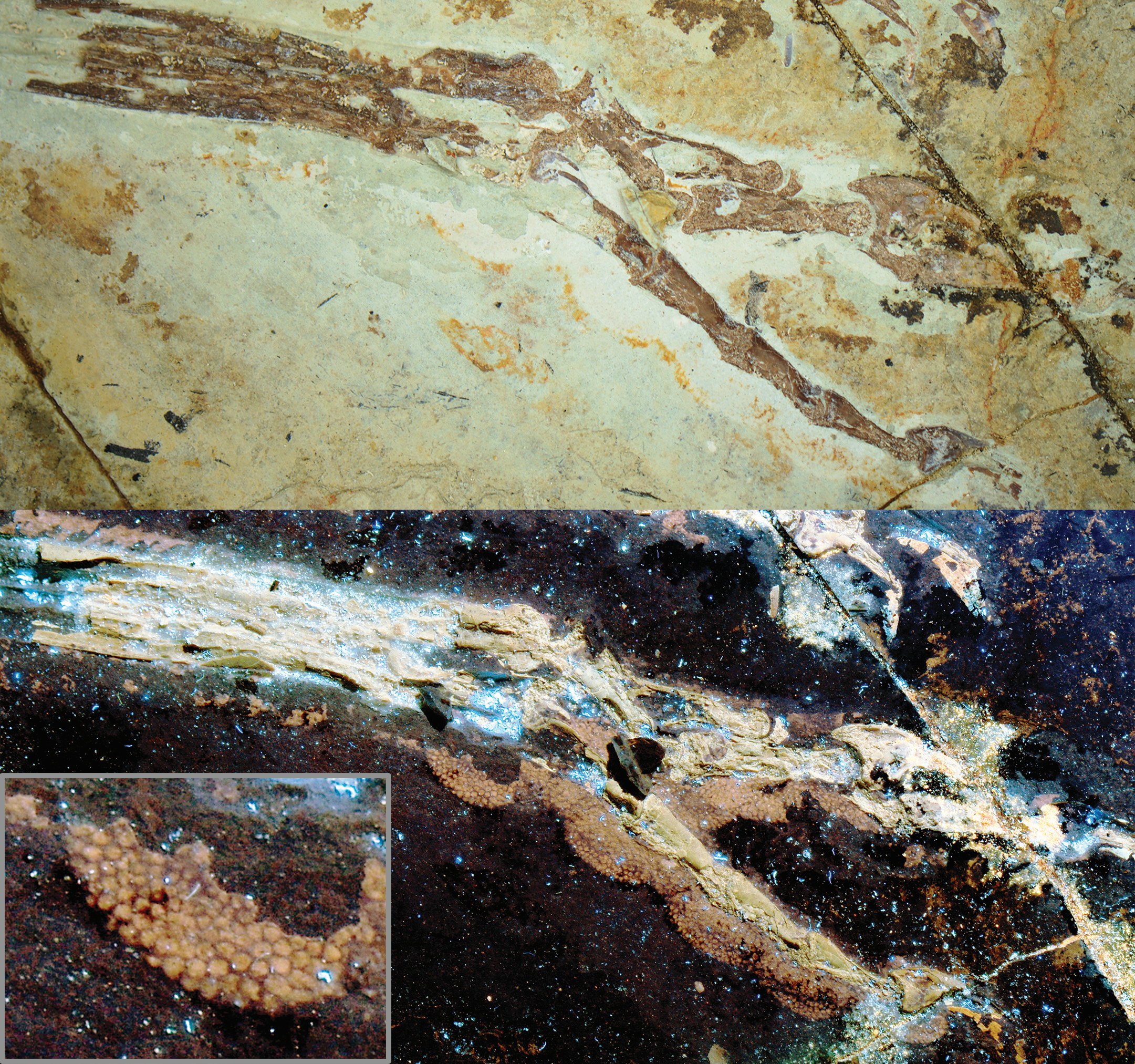
The foot of Anchiornis. Top image shows the foot under normal light. Bottom image shows the foot under laser light. Inset image shows the scaly details of a single footpad. (Image: Wang XL, Pittman M et al. 2017.)
Looking at the high-resolution images, the researchers were able discern the outline of the animal’s arms, legs and tail, but not the head, neck or thorax. Pitman says the outlines were almost certainly the traces of soft tissue, and not artefacts that appeared as a result of the fossilisation process. That said, no chemical analysis was done to determine if the outlines were organic or mineral in nature.
The soft-tissue body outlines showed that Anchiornis had many characteristics of modern birds, including drumstick-shaped legs, a slender tail and a footpad.
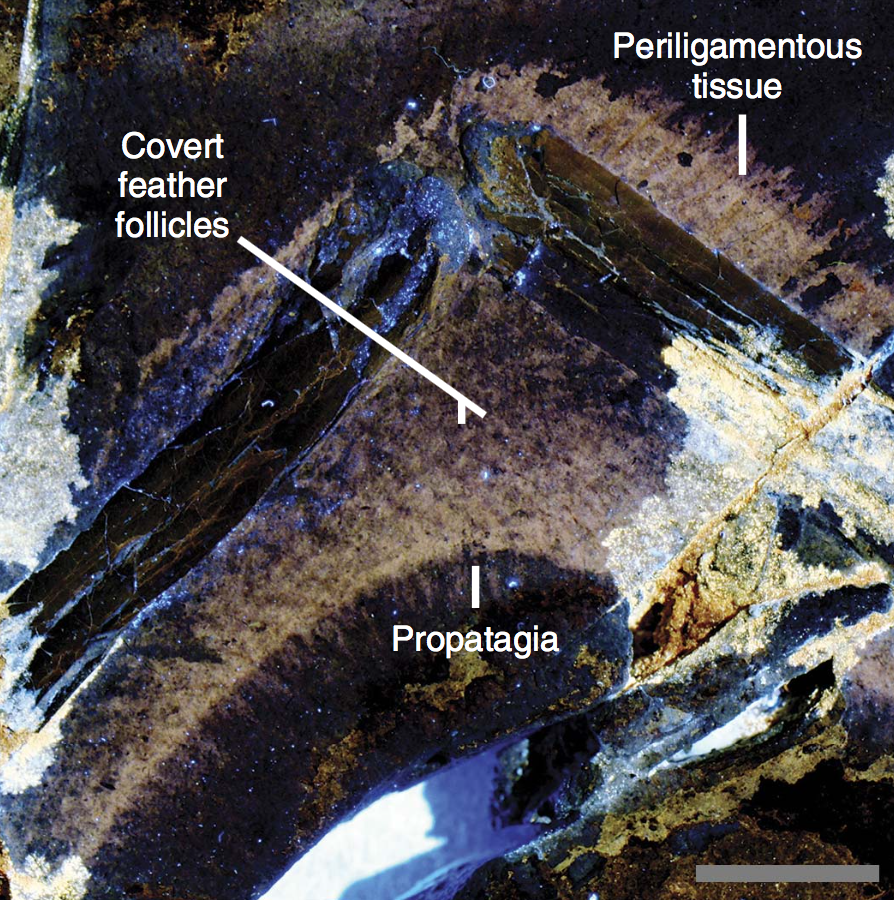
A wing segment showing the propatagia. (Image: Wang XL, Pittman M et al. 2017)
Analysis of the dinosaur’s arms suggests this creature was able (at least in theory) to generate lift — an important prerequisite for flight. Specifically, the researchers noticed a build up of tissue around the elbow, called propatagium, in a thick configuration similar to modern gliding birds such as cormorants, albatrosses and pelicans. This is the first time scientists have seen this feature in such an early bird-like dinosaur. It also appears that Anchiornis was able to control its tail separately from its limbs, allowing for fine bodily control while gliding through the air.
It’s not clear if Anchiornis could actually fly, but given these physical features, it might have been capable of making considerable leaps and engaging in gliding behaviour. But, as the researchers point out, more work is needed to determine if Anchiornis could actually leave the ground or jump off a tree or cliff in any meaningful way.
“The wings of Anchiornis are reminiscent of the wings of some living gliding and soaring birds, but detailed investigation, specifically quantitative biomechanical modelling that can constrain how this animal could have moved, is required to robustly test whether Anchiornis could have glided, soared or even moved through the air at all,” said Pitman. “At the moment we don’t have all the data we need to strongly support any of these capabilities.”
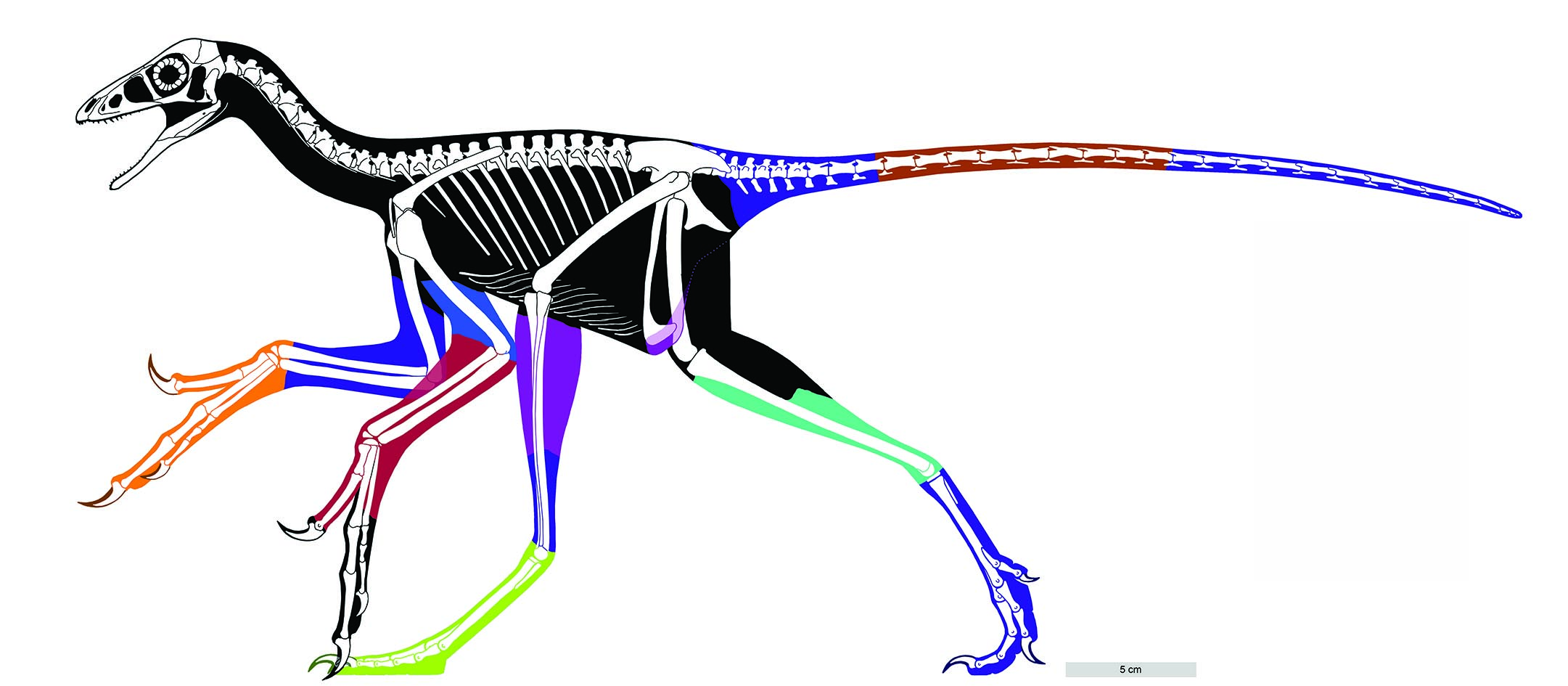
Reconstructed body outline of Anchiornis. Coloured areas represent different fossil specimens and black areas are approximated reconstructions. (Image: Wang XL, Pittman M et al. 2017)
Combined with previous research, the new study probably offers our most accurate glimpse of this ancient creature. Looking ahead, the researchers say their findings could be used to discern other possible aerodynamic features. Thanks to this discovery, we’re now an important step closer to understanding the origin of birds, and how they evolved the capacity for flight.
[Nature]
